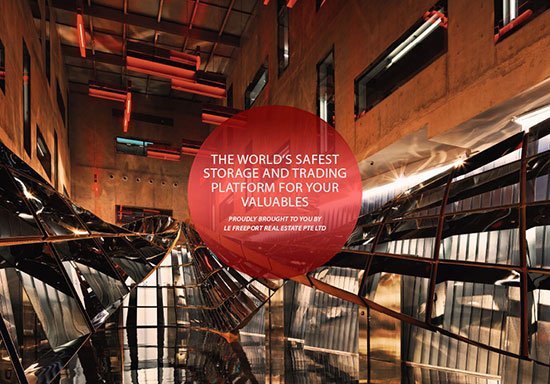The point of departure for tonight’s event is a two-part essay by Berlin-based theorist Stefan Heidenreich, “Freeportism as Ideology and Style: Post-Internet and Speculative Realism.” Part I was published in March, in e-flux journal 71, and Part II appears in the most recent issue.
Freeports, if you’re not familiar, are storage facilities in places with favorable tax laws, like Switzerland, that store goods tax-free while “in transit,” during which they exist in a kind of territorial limbo. Theoretically, this is supposed to be a temporary arrangement, the idea being that the owner will ultimately pay import duties or taxes once the items reach their final destination. In practice, however, there are few, if any, restrictions on how long goods can stay there; so long as they remain on the premises, owners pay no tax, making freeports a particularly appealing place to store valuable luxury objects like fine art. (This New Yorker article from February provides a fascinating glimpse into the notoriously secretive inner workings of the Geneva Freeport.)
Heidenreich’s argument is complex, and worth reading in full, but I’ve attempted a summary below:
As Heidenreich notes, the “free” in freeport takes on a double meaning: not only are these works free of taxes and customs duties, but also of an audience. Following Hito Steyerl’s conception of “duty-free-art,” elaborated in an essay of the same name in e-flux journal 63 (March 2015), Heidenreich sees “freeportism” as a new “mode of representation” for art, arguing, in his essays, that post-internet art and speculative realism serve as its “corresponding style and ideology, respectively.”
In the wake of the 2008 housing crisis and global recession, certain kinds of assets, such as art, became comparatively safe places to park money. However, moving those artworks around introduces risk: things get damaged, shipping is expensive, etcetera. Hence the great appeal of the freeport: artworks can accrue value or change ownership while remaining all the while in tax-free, climate-controlled storage units, drawing them even closer to the status of immaterial financial products. Paradoxically, it is precisely by remaining hidden from view, unable to be appreciated as an aesthetic object, that artworks can maximize their value as assets.
Heidenreich argues that post-internet art has essentially internalized and reproduced the logic of “freeportism”:
The successful freeport artwork requires a strong artistic brand, ample liquidity in the form of tradeable artworks, galleries operating as market makers, and photogenic material objects that produce likable images on platforms such as Instagram and Facebook.”
…
The kind of art known as ‘post-internet’ adapted to these conditions within a relatively short period of time—about five years—mostly by leaving aside its initial focus on web-related practices and processes. This transformation has turned ‘post-internet’ art into a style of freeportism as such, much in the same that, once upon a time, it could have been argued that Dutch still-life painting, with its depiction of worldly goods, was the style of the early financial market that flourished around the Amsterdam stock exchange.
“Freeportism,” for Heidenreich, isn’t just about the artworks that find themselves literally stored at a freeport, but also “work that strives to do so.” (I’m not sure if he means that in a metaphorical sense—e.g., work that is ideologically aligned with the ethos of the freeport—or more literally, in the sense of artworks that are consciously created with the intention that they might accrue enough market value to make them worth storing in one.)
In the second part of the essay, Heidenreich explores the art world’s recent love affair with “Speculative Realism” as a philosophical current. He argues that Speculative Realism serves as the ideal ideological and discursive link between the practices of financial markets and of post-internet artists, via a practice he calls “Philosophical Hedging.” Like hedging in financial markets, a means of minimizing risk by, for instance, buying options or futures in an attempt to stabilize the future value of a market position, “Philosophical Hedging” attempts to use philosophy to stabilize the significance—and thus, I suppose, market value—of artworks. As museums and institutions increasingly focus on contemporary art rather than the construction of a canon into which artists can be inserted and evaluated against, they no longer provide the role as a “stabilizing force” in the art market, as guarantors of an artist’s historical significance. Heidenreich argues that philosophy has taken up that role in their place, offering the stamp of authority, seriousness, and tradition.
Heidenreich suggests that the main concepts associated with Speculative Realist thinkers—like materialism, object-oriented ontology, and “anti-correlationism”—ultimately provide “a justification for an artistic production that goes straight from the artist’s studio to the storage facility, without ever being publicly displayed or shown to anybody.” In his conclusion, he challenges theorists like Suhail Malik, arguing that Speculative Realism does not, as Malik argues, suggest new and alternative trajectories for art outside of its current conditions, but rather provides the perfect ideological cover for “freeportism,” in which artworks are privileged above all as speculative financial assets.
Given that Heidenreich’s essay seems ultimately quite pessimistic about contemporary artists’ relationships to, and complicity in, “freeportism,” I’m particularly interested to hear what our panelists tonight make of this argument, given that all of them are artists, and several of them have been closely linked with the term post-internet.
See you all at 7:30!




